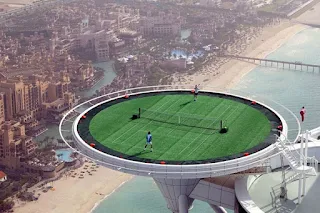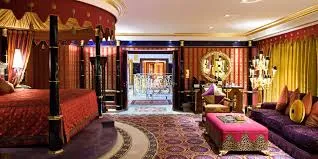The Burj al-Arab is a luxury hotel located in Dubai, United Arab Emirates. It is the fourth tallest hotel in the world; however, 39% of its total height is made up of non-occupiable space. Burj Al Arab stands on an artificial island 280 m (920 ft) from Jumeirah beach and is connected to the mainland by a private curving bridge. The shape of the structure is designed to mimic the sail of a ship. It has a helipad near the roof at a height of 210 m (689 ft) above ground. The beachfront area where Burj Al Arab and Jumeirah Beach Hotel are located was previously called Chicago Beach. The hotel is located on an island of reclaimed land 280 meters offshore of the beach of the former Chicago Beach Hotel. The locale's name had its origins in the Chicago Bridge & Iron Company which at one time welded giant floating oil storage tanks, known locally as Kazzans on the site.
The old name persisted after the old Hotel was demolished in 1997. Dubai Chicago Beach Hotel remained as the Public Project Name for the construction phase of Burj Al Arab Hotel until Sheikh Mohammed bin Rashid Al Maktoum announced the new name.
Burj Al Arab was designed by multidisciplinary consultancy Atkins, led by architect Tom Wright, who has since become co-founder of WKK Architects. The design and construction were managed by Canadian engineer Rick Gregory also of WS Atkins. Construction of the Island began in 1994 and involved up to 2,000 construction workers during peak construction. It was built to resemble the billowing spinnaker sail of a J-class yacht. Two "wings" spread in a V to form a vast "mast", while the space between them is enclosed in a massive atrium. The architect Tom Wright said "The client wanted a building that would become an iconic or symbolic statement for Dubai; this is very similar to Sydney with its Opera House, London with Big Ben, or Paris with the Eiffel Tower. It needed to be a building that would become synonymous with the name of the country."
Fletcher Construction from New Zealand was the lead joint venture partner in the initial stages of pre-construction and construction. The hotel was built by South African construction contractor Murray & Roberts and Al Habtoor Engineering. The building opened in December 1999.
Several features of the hotel required complex engineering feats to achieve. The hotel rests on an artificial island constructed 280 m (920 ft) offshore. To secure a foundation, the builders drove 230 forty-meter-long (130 ft) concrete piles into the sand. Engineers created a ground/surface layer of large rocks, which is circled with a concrete honeycomb pattern, which serves to protect the foundation from erosion. It took three years to reclaim the land from the sea, while it took fewer than three years to construct the building itself. The building contains over 70,000 m3 (92,000 cu yd) of concrete and 9,000 tons of steel. Inside the building, the atrium is 180 m (590 ft) tall.
Burj Al Arab is the world's third tallest hotel (not including buildings with mixed use). The structure of the Rose Rayhaan, also in Dubai, is 11 m (36 ft) taller than Burj Al Arab
The old name persisted after the old Hotel was demolished in 1997. Dubai Chicago Beach Hotel remained as the Public Project Name for the construction phase of Burj Al Arab Hotel until Sheikh Mohammed bin Rashid Al Maktoum announced the new name.
Burj Al Arab was designed by multidisciplinary consultancy Atkins, led by architect Tom Wright, who has since become co-founder of WKK Architects. The design and construction were managed by Canadian engineer Rick Gregory also of WS Atkins. Construction of the Island began in 1994 and involved up to 2,000 construction workers during peak construction. It was built to resemble the billowing spinnaker sail of a J-class yacht. Two "wings" spread in a V to form a vast "mast", while the space between them is enclosed in a massive atrium. The architect Tom Wright said "The client wanted a building that would become an iconic or symbolic statement for Dubai; this is very similar to Sydney with its Opera House, London with Big Ben, or Paris with the Eiffel Tower. It needed to be a building that would become synonymous with the name of the country."
Fletcher Construction from New Zealand was the lead joint venture partner in the initial stages of pre-construction and construction. The hotel was built by South African construction contractor Murray & Roberts and Al Habtoor Engineering. The building opened in December 1999.
Several features of the hotel required complex engineering feats to achieve. The hotel rests on an artificial island constructed 280 m (920 ft) offshore. To secure a foundation, the builders drove 230 forty-meter-long (130 ft) concrete piles into the sand. Engineers created a ground/surface layer of large rocks, which is circled with a concrete honeycomb pattern, which serves to protect the foundation from erosion. It took three years to reclaim the land from the sea, while it took fewer than three years to construct the building itself. The building contains over 70,000 m3 (92,000 cu yd) of concrete and 9,000 tons of steel. Inside the building, the atrium is 180 m (590 ft) tall.
Burj Al Arab is the world's third tallest hotel (not including buildings with mixed use). The structure of the Rose Rayhaan, also in Dubai, is 11 m (36 ft) taller than Burj Al Arab
Suites feature design details that juxtapose east and west. White columns show great influence. Bathrooms are accented by mosaic tile patterns. The Royal Suite, billed at US$24,000 per night, is listed at number 12 on World's 15 most expensive hotel suites compiled by CNN Go in 2012. The Burj Al Arab is very popular with the Chinese market, which made up 25 percent of all bookings at the hotel in 2011 and 2012.
Al Muntaha ("The Ultimate"), is located 200 m (660 ft) above the Persian Gulf, offering a view of Dubai. It is supported by a full cantilever that extends 27 m (89 ft) from either side of the mast, and is accessed by a panoramic elevator and Al Mahara ("Oyster"), which is accessed via a simulated submarine voyage, features a large seawater aquarium, holding roughly 990,000 L (260,000 US gal) of water. The wall of the tank, made of acrylic glass in order to withstand the water pressure, is about 18 cm (7.1 in) thick
The Burj Al Arab is a five-star hotel, the highest official ranking. While the hotel is sometimes erroneously described as "the world's only seven-star hotel", the hotel management claims to never have done that themselves. In the words of a Jumeirah Group spokesperson: "There's not a lot we can do to stop it. We're not encouraging the use of the term. We've never used it in our advertising. A look upward reveals the dramatic atrium, the world's tallest. The white sails covering the outer side of the atrium are used as a screen for the nightly light show at the Burj Al Arab. Some 2,000 sq m of 22-carat gold leaf have been used in the decor of the lobby and the restaurants, together with Italian marble (one of nearly 30 different types used throughout the property), Brazilian granite and custom-made carpets. The lobby, dotted with huge golden columns, leads to several boutiques and restaurants.
for more details = The Burj al-Arab official website

























No comments:
Post a Comment
Stay updated with our blog for more quality content! Your feedback is appreciated. Contact us at harshrex@outlook.com with any suggestions.